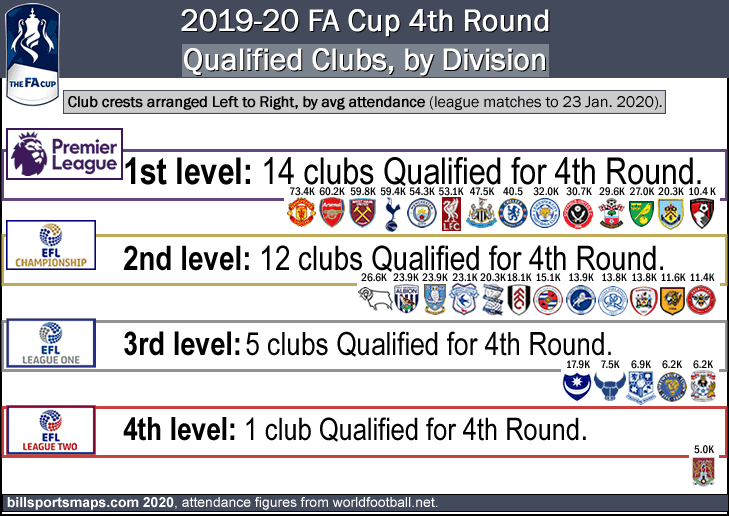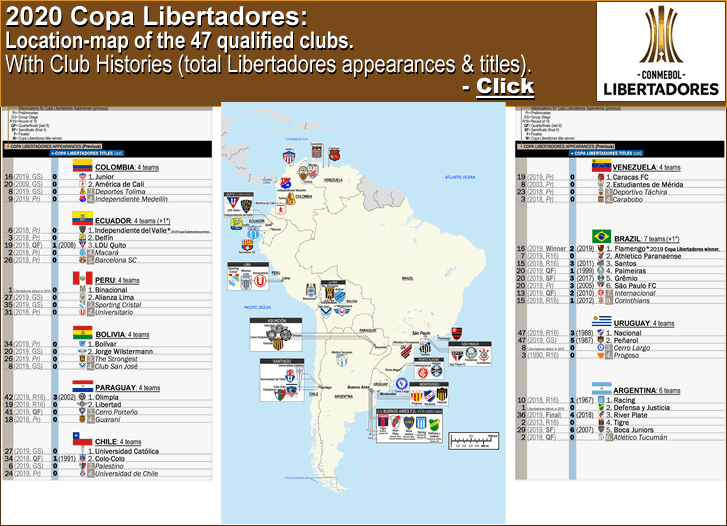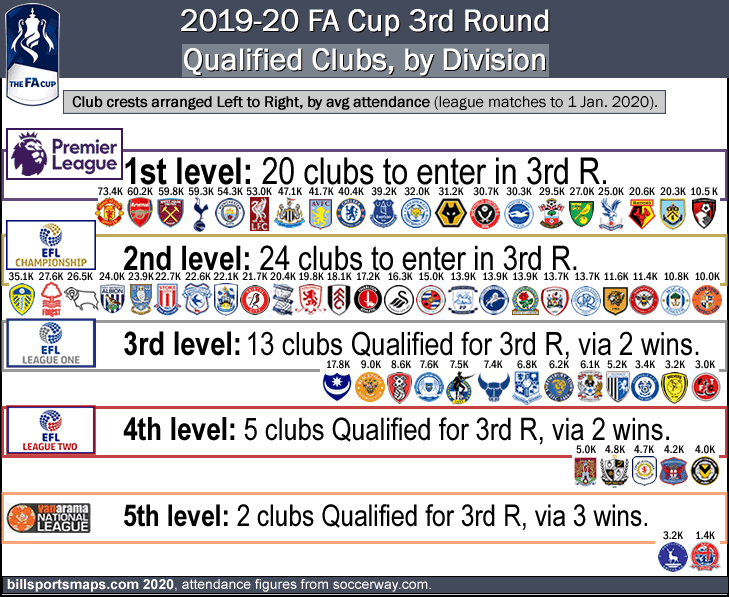
American Football League: 1962 AFL season, map with helmets/jerseys & final standings
…
…
By Bill Turianski on 28 January 2020; twitter.com/billsportsmaps.
Links…
-1962 AFL season
-1962 AFL Championship Game (en.wikipedia.org).
-1962 AFL season (pro-football-reference.com).
-Illustrated History of Kansas City Chiefs’ uniforms (1960 to 2018)…from Gridiron Uniforms Database (gridiron-uniforms.com).
The map (click on image at the top of the post)…
The map shows the primary helmets and jerseys worn by the 8 AFL teams of 1962, the third season of the American Football League (IV) (1960-69). At the lower-right of the map-page are the final standings of the 1962 AFL, along with home jerseys and helmets of the 8 AFL teams of 1962. At the bottom-right corner are the attendance figures for the 1962 AFL season. At the upper-right of the map-page are standout players for the champions, the 1962 Dallas Texans (the franchise that became the Kansas City Chiefs in the following season of 1963). Below the Dallas Texans of 1962 section of the map page, is a section for 1962 AFL Offensive Leaders, in the following categories: QB Rating & TD Passes: Len Dawson, Dallas Texans. Passing Yardage: Frank Tripucka, Denver Broncos. Rushing Yardage: Cookie Gilchrist, Buffalo Bills. Yards from Scrimmage & Total TDs: Abner Haynes, Dallas Texans. Receiving Yards: Art Powell: New York Titans.
In the 1962 AFL Championship Game, played at Jeppesen Stadium in Houston, Texas, on December 23 1962, the Dallas Texans defeated the Houston Oilers 20-17 in double-overtime. The Texans, coached by Hank Stram and led by QB Len Dawson, had two TDs by RB Abner Haynes. But it took 17:54 of overtime play (2:54 into the 6th quarter), for the Texans to get a 25-yard FG to beat the Oilers (who were the two-time-reigning AFL champions). It was, at the time, the longest pro gridiron football game ever played, and to this day it remains the longest championship game played in the sport. {See photos in illustration further below.}
…
- The AFL (of 1960-69) had a 10-year battle with the established pro football league, the NFL.
In 1970, the AFL essentially won the battle, by virtue of the fact that the NFL allowed all 10 of the AFL franchises to join the NFL, in a full dual-league merger. Plus, the AFL won the last two match-ups with the NFL…Super Bowl III (1968 season) saw the AFL’s New York Jets beat the NFL’s Baltimore Colts, and Super Bowl IV (1969 season) saw the AFL’s Kansas City Chiefs beat the NFL’s Minnesota Vikings {see the next few paragraphs for more on that}.
After the 1962 AFL season, there were two AFL franchises that would soon change their identities dramatically. These two teams in 1962/63 were the very competitive Dallas Texans (soon to become the Kansas City Chiefs), and the hapless and broke New York Titans (soon to become the New York Jets). These two franchise-changes following the 1962 season considerably helped the AFL in its battle for legitimacy.
The Dallas Texans, who went on to win the 1962 AFL Championship Game, were saddled with a taxing local rivalry with the NFL’s Dallas Cowboys. The AFL team could not compete with the drawing-power of the NFL, despite the fact that the AFL team in Dallas (the Texans) were championship-caliber, while the NFL team in Dallas (the Cowboys) were, at this point in time, a basement-dwelling expansion team. The NFL was just too powerful for even a title-winning AFL team to compete with. {More on this can be seen in the Texans/Chiefs’ Stadiums section, 8 and 9 paragraphs further below.}
In May 1963, 5 months after winning the 1962 title, the AFL’s Texans would leave Dallas, moving 450 miles north to Kansas City, Missouri, to become the Kansas City Chiefs. (The Texans/Chiefs franchise would not change ownership, or color-scheme, with the move). And the New York Titans, under new and more well-funded ownership, would change their name to the New York Jets, changing from dark-blue/yellow-gold colors to green-&-white. And a year after that, in 1964, the re-branded NY Jets would move from the decrepit Polo Grounds in northern Manhattan, NYC to the brand-new Shea Stadium in Queens, NYC…and soon started drawing 50 thousand per game. The Chiefs would not go on to draw quite as well as the Jets would, but they ably filled their new home in KC, the MLB ballpark known as Municipal Stadium. By 1966, the Chiefs were drawing 37-K-per-game, and by 1969 they were drawing 49-K-per-game. {You can see a color photo of their home venue back then (Municipal Stadium in gridiron-football-configuration), and Texans/Chiefs attendance figures, in the illustration below).
And the Kansas City Chiefs kept on with the winning ways they had had in Dallas. The Texans/Chiefs franchise would go on to win two more AFL titles (in 1966 and 1969), as well as winning Super Bowl IV (#4) in January of 1970 (the last of four head-to-head match-ups between the AFL and the NFL) {also see in illustration below}. The Chiefs’ Super Bowl upset-win (over the Vikings) came one year after the AFL pulled off its greatest feat in its 10-year history, when the New York Jets shocked the gridiron football world by beating the heavily-favored Baltimore Colts in Super Bowl III (#3) in January of 1969.
So, the roots of the AFL’s eventual triumph over the NFL, in Super Bowls III and IV, can be found in the time between the 1962 and 1963 AFL seasons, when the Kansas City Chiefs and the New York Jets came into existence.
…
Note: the article below first appeared in this post from 2014, on the NFL’s AFC West Division…
NFL, AFC West – Logo and helmet history of the 4 teams (Broncos, Chiefs, Raiders, Chargers)./ Origins of nicknames./ Stadiums./ Title-winning teams.
- The Dallas Texans/Kansas City Chiefs: 3 AFL titles & 1 Super Bowl title in a 10-year-span…

Photo and Image credits above -
1960-62 Dallas Texans helmet, illustration from gridiron-uniforms.com/chiefs. Albert Haynes, photo unattributed at sportsnola.com. Photo of 1962 Dallas Texans AFL Champions team photo, unattributed at media-cache-ak0.pinimg.com. Hank Stram with AFL championship trophy, photo unattributed at media-cache-ak0.pinimg.com. Abner Haynes in 1962 AFL title game, photo unattributed at ntmeangreenfootball.com. USA blank map by Zntrip at Blank map of the United States. Aerial photo of Kansas City Chiefs playing at Municipal Stadium, photo by Kansas City Chiefs at kcchiefs.com/municipal-stadium-tribute. Hank Stram being carried off the field by Chiefs players after their 1966 AFL Championship Game win over Buffalo, photo unattributed at mmbolding.com/AFL1966. AFL 10 years patch worn by Chiefs in Super Bowl IV, photo unattributed/ uploaded by remembertheafl.com at Super Bowl IV (en.wikipedia.org). Len Dawson taking the snap in Super Bowl IV vs. Vikings, photo unattributed at arrowheadaddict.com/2013/06/16/chiefs-history-and-an-anniversary. Buck Buchanan and Curley Culp tackling Dave Osborn in Super Bowl IV, photo from USA Today via spokeo.com.
…
- Kansas City Chiefs – logos and helmet history (1960-2019), click on image below…
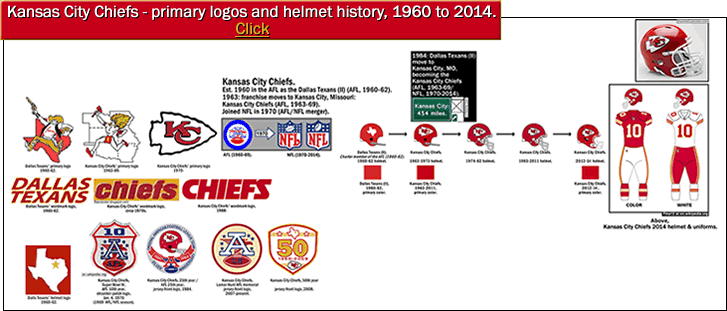
Kansas City Chiefs – logos and helmet history (1960-2014)
Texans/Chiefs helmet illustrations above from gridiron-uniforms.com/chiefs. Chiefs uniforms.png by fma12, en.wikipedia.org/wiki/File:Chiefs_uniforms.png. Photo of Chiefs 2012-13 Riddell helmet from thumbs3.picclick.com/d/w225/pict/251241604074_/KANSAS-CITY-CHIEFS-Riddell-Revolution-NFL-Football-Helmet.jpg. Dallas Texans’ 1960-62 wordmark logo from sportsecyclopedia.com/nfl/kcdal/daltexans. Photo of Chiefs’ circa 1970s wordmark logo from fleersticker.blogspot.com.
Origin of Chiefs nickname…
Upon moving his AFL franchise the Dallas Texans to Kansas City, Missouri in 1963, oil-fortune-heir Lamar Hunt was faced with the quandary of having to re-name his franchise. But actually, as hard as it is to believe, Hunt (at first) wanted to keep the nickname and call the team the Kansas City Texans. It took his right-hand-man, Jack Steadman (who was the Texans/Chiefs GM and vice president of operations), to convince Hunt otherwise. The mayor of Kansas City then, H. Roe Bartle, who was very instrumental in the city being able to lure the AFL franchise away from Dallas, was nicknamed “the Chief” (from his days as a Scout Executive of the St. Joseph and Kansas City Boy Scout Councils 35 years previously when he formed a Native Tribes honor society within the Boy Scouts called The Tribe of Mic-O-Say).
The Chiefs became the winning entry (but not the most popular entry by far) into the local name-the-new-team contest that Hunt had organized. The most popular of the 4,866 entries (with 1,020 different names being suggested) were for the nicknames the “Mules” and the “Royals.” “Chiefs”, suggested by 42 entries, was third-most-selected in the naming contest; nevertheless Hunt selected Chiefs as the football team’s new nickname. At other sources (like here) it is said Hunt re-named the team the Chiefs in honor of the large number of Native Americans who (past and present) had called the region of western Missouri and the Great Plains their home. At that is technically true. And that notion is re-enforced by the first primary logo of the new Chiefs franchise {see it by clicking on the on the image above or here}.
But the Chiefs are also named after the nickname of that former Kansas City mayor, H. Roe Bartle who helped get the team to KC and who made good on his promise to Lamar Hunt that Kansas City would have a vast season-ticket paying fan-base there even before the team’s arrival. And this was swiftly accomplished, as in a short span of time (8 weeks) in early 1963, over 20,000 season season tickets were sold to pro-football starved fans in and around Kansas City – before the franchise had even moved out of Dallas, and before the folks who forked over cash for the season tickets even knew exactly which pro team the city was getting. As it said in the timeline/1963 section of the official Kansas City Chiefs website, “the team was officially christened the Chiefs on May 26th, in part to honor the efforts of Bartle.” {excerpt from http://www.kcchiefs.com/history/60s/ [dead link/ now available via Wayback Machine at http://web.archive.org/web/20080609053609/http://www.kcchiefs.com/history/60s/ }.
For more on this, see the following article at SBnation, How the Kansas City Chiefs Got Their Name (article by oldchiefsfan from May 18 2009). In the comments section there, 2 commenters who were proud childhood members of the Boy Scouts' Tribe of Mic-O-Say weigh in: jbj8609 says ..."My father and I are both members of MOS (in St. Joseph, MO, not the KC one), and I can confirm this to be 100% accurate. My dad has been “Tribal Historian” here for several years now and used to tell me this story many times. Always thought it was very cool"; bankmeister says..."I’m also a Mic-O-Say member with five consecutive years at Bartle, plus my mom has lived off of Roe Avenue for 25 years. H. Roe and the Chiefs mean a lot to me." {end of excerpts.} The Kansas City Chiefs is a great name that honors Native Americans. Unlike the racist name of another NFL team.
- Stadiums the Dallas Texans (II)/Kansas City Chiefs franchise have played in...
Cotton Bowl in Dallas, Texas (home of the Dallas Texans (II) from 1960-62)...
The Cotton Bowl began as Fair Park, a stadium built on the site of the Texas State Fair grounds, in 1930. Cut-and-fill construction was employed to build up berms for the stands, and this lowered the playing surface twenty-four feet below the original ground level. The stadium initially held 45,000 spectators; in 1936, the name was officially changed to the Cotton Bowl. The following year, 1937, the Cotton Bowl Classic college football Bowl game began being played there. But it wasn't a popularly-attended Bowl game until a partnership was created with the Southwest Conference starting in 1941 (and the Texas A&M versus Fordham game in '41 was the first Cotton Bowl Classic that was played to a sell-out crowd). By 1950 and through the 1960s, the Cotton Bowl could hold 75,000 (it has a 90,000-capacity now). The primary tenant, in its early days through to the mid-1970s, was the SMU Mustangs college football team; the failed NFL franchise the Dallas Texans (I) of 1952 played 4 of their scheduled 6 games there to sparse crowds, before the NFL front office took over the team and folded it at the end of the 1952 NFL season. In 1960, it would be the home of 3 football teams: the SMU Mustangs, the expansion NFL team the Dallas Cowboys, and the Dallas Texans (II), a charter member of the new rival-league, the AFL.
AFL founder Lamar Hunt, though Arkansas-born, was raised in Dallas, Texas (where his father's oil business was centered). His efforts to get an NFL team for Dallas circa 1958-59 had been unsuccessful. When he got the AFL off the ground and running in 1959-to-early-1960, there was never any doubt that he would have one of the 8 franchises in the new league and that it would be located in Dallas. This despite the fact that in the interim - in early 1960 - the NFL had awarded a Dallas franchise to someone else. So Hunt's Dallas Texans were instantly consigned to being the second-team-in-Dallas, simply by virtue of the fact that the NFL was more established. The red-and-yellow/gold Dallas Texans struggled to get media attention in their 3 seasons in Dallas, but in fact, in the team's first year in Dallas (1960), the AFL's Texans drew best in the debut-season of the AFL and outdrew the NFL's Cowboys (24,500 per game for the AFL Texans versus 21,417 per game for the Cowboys). Of course the first-year Cowboys were horrible (they went 0-11-1), while Hunt's Texans were competitive and fun to watch with a prolific-scoring offense (they went 8-6). But the next season, 1961, Texans' attendance plummeted almost 7K per game to 17,571, while the slightly-improved Cowboys (at 4-9-1) saw their attendance shoot up 33% to 24,521 per game. The writing was on the wall for Hunt. As football-crazy and as dynamic and growing as the city of Dallas was in the early 1960s, it still was not big enough to support two pro football teams. In the next season, 1962, even as an 11-3 team en route to the 1962 AFL title (see illustration below), the Texans were still unable to draw as well as they did their first year - they averaged 22,201 (the 5-8-1 Cowboys averaged only slightly less, at 21,778 in '63).
Hunt knew that once the Dallas Cowboys (inevitably) got competitive, they would totally overshadow the Dallas Texans and start claiming a much greater share of the ticket-paying public in the Dallas/Ft. Worth area. So Hunt threw in the towel and began looking for a new home for his team. New Orleans, Atlanta and Miami and Seattle were also considered, but thanks to that huge season-ticket-drive in KC, Hunt moved his team 450 miles north to Kansas City.
Municipal Stadium (Kansas City), home of the Chiefs from 1963-71...
Opened in 1923 and originally called Muehlebach Field, the venue was built as a ballpark for the Kansas City Blues (V) (1902-54) of the American Association. The Kansas City Monarchs Negro leagues team also played there (from 1923-34; 1937-54). For that reason the ballpark was situated at the edge of Kansas City's inner-city neighborhood. Capacity was originally 17,000, with the main feature of the ballpark being a single, roofed stand that ran the whole of the first-base foul-line to the right-field-foul-pole, but on the other side the roof only stretched to third base (making the roof a rounded L-shape). In 1955, prior to the arrival of the Philadelphia Athletics MLB franchise, the city decided to almost completely demolish the stadium and rebuild from scratch. The city ran three shifts - the new stadium was built in 90 days, in time for the April 1955 MLB opening of the Kansas City Athletics (1955-67). The not-quite-V-shaped-roof remained, now in a double-deck form, and capacity for baseball was then 30,000. It was re-named Municipal Stadium.
When Lamar Hunt decided to move his Dallas Texans to Kansas City in early 1963, the stadium was renovated again, but in more of a jury-rigged way - temporary stands were erected in left field to expand the stadium's capacity each fall, but had to be torn down before the start of the baseball season the following year.
Kansas City mayor H. Roe Bartle had helped get the team to KC, and had made good on his promise to Lamar Hunt that Kansas City would have a vast season-ticket paying fan-base there even before the team's arrival. Some sources say that Bartle promised to triple the crowds the team had drawn in Dallas (ie, 21.4 K times 3 equals 64 K) - but even if he did promise that, it would have been impossible because Municipal Stadium in Kansas City only held around 30,000 then, and even after expansion for football, it never had more than a 49,000-capacity {see this, stadiumsofprofootball.com/past/KCMunicipal}. The 1963 Kansas City Chiefs actually drew about 650 per game worse than they did the year before as the 1962 Dallas Texans (at 21,510 per game in 1963 versus 22,201 in '62) (note: 10-year AFL attendance figures for the Dallas Texans (II)/Kansas City Chiefs can be seen in the illustration above, and the source for those figures was at THE AMERICAN FOOTBALL LEAGUE - ATTENDANCE, 1960-69 By Bob Carroll at profootballresearchers.org.)
The Kansas City Chiefs upon arrival in KC in 1963 were reigning champions of the AFL, but the Chiefs then suffered a downturn in form and went 5-7-2 in '63; 7-7 in '64; and 7-5-2 in '65. Cumulative gate figures for those first 3 years in KC were 20,376 per game. So the fact that the Chiefs turned mediocre right when they arrived in KC certainly hurt attendances, and the crowds the Chiefs drew only got respectable after the Chiefs got good again - in 1966, when they tore up the AFL, going 11-2-1, winning the AFL Championship game (over the Bills, 31–7), and appearing in the first AFL-NFL Championship Game [aka Super Bowl I] (losing to the Packers, 35-10). In that great season of 1966, the Chiefs drew 37,010 (an increase of around 15.5 K over their ’65 attendance). Attendance-wise, the Chiefs have never looked back: they drew 45 K in ’67 (going 9-5); 48 K in ’68 (going 12-2); and 49 K in ’69 when they went all the way with an 11-3 record, beating the Raiders 13-6 in the last AFL Championship game and then winning Super Bowl IV [4] by upsetting the heavily-favored Minnesota Vikings by a score of 23-7 in the last game ever played by the AFL (see illustration above).
Following the Jets’ upset of the NFL’s Colts in Super Bowl III, the Chiefs’ similar upset of the Vikings in Super Bowl IV made it plain for all to see that the AFL was the deserved equal of the NFL. Actually, the AFL beat the NFL soundly in the last two match-ups between the two leagues, so it basically looked like the once-derided upstarts had actually surpassed their hide-bound rivals…in ten years flat. The Chiefs played their first two seasons in the NFL at Municipal Stadium (1970-71), then moved into their purpose-built Arrowhead Stadium in September 1972.
Below: the Truman Sports Complex -the first major league sports stadium complex in the USA which rejected the misguided multi-purpose stadium model.

Photo and Image credits above -
Chiefs 2012-14 Pro Revolution helmet, illustration by gridiron-uniforms.com/teams/2012_KansasCity.
Kauffman Stadium and Arrowhead Stadium as seen from the nearby interstate highway, photo unattributed/ uploaded by KingmanIII at skyscrapercity.com/ [thread: Closest stadiums]. Arrowhead Stadium aerial photo, by Ichabod at en.wikipedia.org/ [Arrowhead Stadium page].
Arrowhead Stadium – home of the Chiefs since 1972…
To see how the Chiefs’ Arrowhead Stadium came to be, we need to backtrack about 5 years, back to early 1967. Although having just lost in a convincing fashion to the Green Bay Packers in what we now call Super Bowl I, the Chiefs were nevertheless a solid and growing franchise circa early 1967. They had won 2 AFL titles in six seasons, and were now drawing in the 37,000-per-game range. Half a year later in the autumn of 1967, Chiefs were drawing around 45,000 per game [this after their first 3 years in KC when they had lackluster attendance, failing to draw above 22 K per game (1963-65/see attendance figures in illustration above]). All signs pointed to further attendance increases for the Chiefs. They were playing to nearly-full capacity at this point, and the aging Municipal Stadium, located in its inner-city neighborhood, was becoming inadequate for the them and their fans. Locations for a new stadium for the Chiefs and the Athletics were scouted by the city of Kansas City starting in early 1967, but a suitable location was never found, and so just across the county-line in Jackson County, Missouri, at the far eastern edge of Greater Kansas City, a location adjacent to an interstate highway interchange was designated. Hunt had operations-chief Jack Steadman work on the stadium design. Denver architect Charles Deaton was brought in by Steadman and it was Deaton who suggested that the two teams, playing as they were in sports that had such radically different configurations, would be better served if each team had its own stadium. Its own stadium that was configured to its own sport’s configuration (a rectangular-shaped stadium for the football team, and a half-circle-atop-a-triangle-shaped stadium for the baseball team). The 2 venues could share a parking lot complex which would reduce costs by sharing parking and highway expenses. This was the exact opposite of conventional wisdom of the time. The late 1960s was the heyday of the now-derided multi-purpose stadium era (an era that lasted up to the late 1980s), or as I like to call it, the Robert Moses Disease. Circa 1960 to 1988 or so, the urban planners running metropolitan areas ignored the basic fact of the fundamental incompatibility of putting the two very different sports into the same stadium, and forced ugly, astro-turf laden cookie-cutter, multi-purpose concrete stadiums on the public. The whole idea was “we can put our baseball team and our NFL football team in the same stadium, and who cares if the dimensions of the two sports fields are totally incompatible”.
I am not exaggerating in saying that Mr. Deaton’s visionary idea (which is the norm today), has helped to elevate the fan experience in both the NFL and in Major League Baseball. Once there were over a dozen multi-use stadiums in MLB and in the NFL, and they all sucked, because they were designed to host two very incompatible configurations. They were giant soul-less concrete doughnuts that gave the fan – for either sport – vast yawning empty spaces where there should have been seats, and sight-lines looking upon totalitarian-architecture backdrops of brutal concrete. [By 2010, following the Minnesota Twins opening of their Target Field, there was only one multi-purpose stadium still in use in both the NFL and MLB - Oakland's stadium, and its days are numbered.]
Here is an excerpt from the Kauffman Stadium page at en.wikipedia.org,…”In 1967, voters in Jackson County, Missouri approved the bonds for Truman Sports Complex, which featured a football stadium for the Kansas City Chiefs and a baseball stadium for the Kansas City Athletics, whose owner, Charles O. Finley, had just signed a new lease to remain in Kansas City. This was a very unusual proposal; conventional wisdom at the time held that separate football and baseball stadiums were not commercially viable.”…{end of excerpt from en.wikipedia.org/wiki/Kauffman_Stadium#History. The two stadium sports complex, what became known as the Truman Sports Complex, would prove to be twenty years ahead of its time.
But then a wrench was thrown into the works when, in October, 1967, MLB gave A’s owner Charlie Finley permission to move his Kansas City Athletics MLB franchise west to Oakland, CA (in 1968). The folks in and around Kansas City were so enraged about losing their pro ball club they pressured their elected officials to act. Partly thanks to the threat to introduce legislation in the US Senate to remove MLB’s antitrust exemption (put forth by Missouri Senator Stuart Symington), MLB hastily began plans for another round of expansion at the winter meetings in 1967, so both Kansas City and Seattle got MLB AL expansion franchises; and both San Diego and Montreal, Quebec, Canada got MLB NL expansion franchises, all 4 teams set to begin play in 1969.
At about the same time, the Jackson County Sports Complex Authority was created, and construction began in 1968 for the two-stadium Truman Sports Complex (named in honor of western-Missouri-born-and-bred President Harry S. Truman). The second-year Kansas City Royals began playing at the new 37,000-capacity Royals Stadium in April, 1972 (the venue is now called Kauffman Stadium in honor of the Royals’ first owner, Ewing Kauffman). The Chiefs began playing at the new 78,000-capacity Arrowhead Stadium in September, 1972 (after several renovations, Arrowhead, since 2010, now has a capacity of 76,416). The original two-stadium concept, initially designed by Denver architect Charles Deaton and Jack Steadman, was implemented in its final design by the Kansas City architectural firm of Kivett & Myers. The template for what was to be called Arrowhead Stadium is said to have influenced the design of several NFL stadiums. Both stadiums were very well designed and have had very good upkeep – both stadiums are still in excellent shape. And both teams have no plans of moving elsewhere (either out of town or into another costly new stadium), as opposed to the case with EIGHT now-demolished multi-purpose stadiums that were built in the USA in the same era or later. Specifically, in Minneapolis (Metrodome demolished in 2014), in Queens, New York (Shea Stadium demolished in 2007), in St. Louis (Busch Memorial Stadium demolished in 2005), in Philadelphia (Veterans Stadium demolished in 2004), in Cincinnati (Riverfront Stadium demolished in 2002), in Pittsburgh (Three Rivers Stadium demolished in 2001), in Seattle (Kingdome demolished in 2000) and in Atlanta (Atlanta–Fulton County Stadium demolished in 1997) [note: soon Candlestick Park in San Francisco can be added to this list of demolished multi-purpose stadiums, as with the vacating of the 49ers after the 2013 season, the dreary Candlestick Park has no primary tenant].
…
Below: Lamar Hunt and Bud Adams (photo circa 1960)…
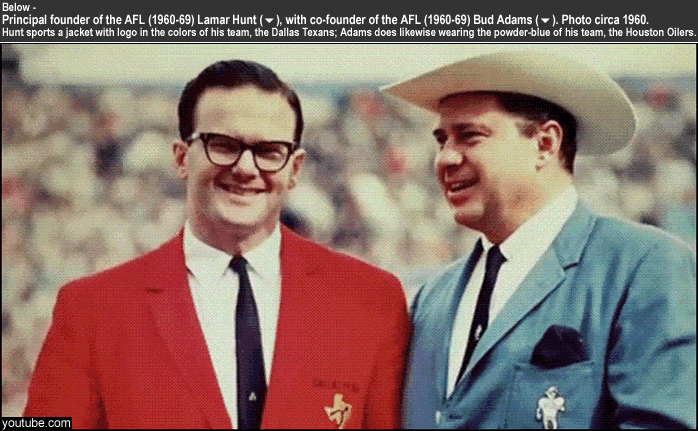
Image credit above -youtube.com/watch?v=W1sL0gf_LXI (youtube.com video uploaded by Scott Sillcox).
- Colors and helmet logos of the Texans/Chiefs
The following link is to a 1 minute and 53 seconds-long video (produced by the NFL and Tide detergent), Kansas City Chiefs uniform and uniform color history (video uploaded by Scott Sillcox at youtube.com)}.
-Illustrated History of Kansas City Chiefs’ uniforms (1960 to 2018)…from Gridiron Uniforms Database (gridiron-uniforms.com).
1960-62 – Red and Yellow/Gold (map-of-Texas-with-gold-star-for-Dallas helmet-logo, on a plain red helmet)…
Lamar Hunt actually wanted the Dallas Texans to wear orange-and-sky-blue, but Bud Adams’ Houston Oilers had already chosen powder blue as their primary color, so Hunt had to come up with a different color scheme (thank goodness for that). Hunt chose a simple yet striking red-with-yellow/gold…the franchise has never worn any other colors. The Texans/Chiefs have also only worn a red helmet with no stripe detail (a wise decision because the inherent high-potency of the color red ends up being diluted by the often-at-cross-purposes imposition of a center stripe…especially when that red is paired with a shape in the logo that is slightly more complex than a block letter or a circle). First (1960-62), the red helmet had a logo that was the-state-of-Texas-with-gold-star-for-Dallas {see that nice design here in a game-worn helmet from the 1960-62 era}.
1963-2019 – Red and Yellow/Gold (arrowhead-with-interlocking-K-C helmet-logo, on a plain red helmet)…
When Hunt moved the team to Kansas City, the story goes he himself drew out the new logo in his kitchen on a dinner napkin…sketching out a design influenced by the San Francisco 49ers’ interlocking-S-F, but with an arrowhead framing the letters K-C instead of the football-shaped-oval on the Niners’ helmet. That design debuted in 1963 and, aside from a slight reshaping of the logo in 1974 (the arrowhead was made a bit smaller and the K-C a bit larger), it has remained the Chiefs helmet design for over 50 years. And rightly so. The Chiefs’ bold yet dignified helmet looks as sharp today as it did a half century ago; the same can be said for their uniforms.
…
Credits
Dallas Texans on map page,
Video of 1962 AFL Championship Game [Len Dawson about to pass to Abner Haynes], screenshot of video uploaded by NFL at youtube.com. Dallas Texans game-worn helmet, photo from milehighcardco.com/1960-62-dallas-texans-afl-game-used-helmet. Jerry Mays [1962 Fleer card], from ebay.com. Mel Branch [photo circa 1962], unattributed at goldenrankings.com/AFLchampionship1962. EJ Holub [photo from 1962 title game], unattributed at goldenrankings.com/AFLchampionship1962. Sherrill Headrick [photo from 1961], unattributed at helmethut.com/Features/Dr.Ken148. Len Dawson [1962 title game] screenshot from video uploaded by Rusty Brewer at youtube.com. [photo from 1962], unattributed at pinterest.co.uk. Chris Burford [1964 Topps card], from peacework.us/su/delt60/Burford_Chris. Abner Haynes [photo from 1962], AP via si.com/nfl. Jim Tyrer [1964 Topps card], from bleacherreport.com.
Offensive stats leaders on map page,
Len Dawson [1963 Fleer card], from myalltimefavorites.com. Frank Tripucka [1963 Fleer card], from comc.com. Cookie Gilchrist [photo from 1963], from buffalobills.com via wkbw.com. Abner Haynes [1962 Fleer card], from ebay.com. Art Powell [1962 Fleer card] from ebay.com.
…
Thanks to,
-Blank map by anonymous US federal government employee, at File:StatesU.svg (commons.wikimedia.org).
-Thanks to Sportslogos.net for 1960-era AFL team logos.
-Thanks to Buffalo Bills official site for original Bills logo (1960-61).
-Thanks to Infinite Jets blog for hard-to-find full-color NY Titans logo.
Thanks to the Coffin Corner newsletter, for this pdf, [AFL attendance by team 1960-69] (profootballresearchers.org).
-Thanks to the contributors at pro-football-reference.com.
-Thanks to the contributors at AFL 1962 season (en.wikipedia.org).
Special thanks to Tim Brulia, Bill Schaefer and Rob Holecko of The Gridiron Uniform Database, for giving billsportsmaps.com the permission to use football uniforms illustrations from Gridiron Uniform Database {GUD}.

